“The Tholian Web”
Written by Judy Burns & Chet Richards
Directed by Ralph Senensky (uncredited) and Herb Wallerstein
Season 3, Episode 9
Production episode 60043-64
Original air date: November 15, 1968
Stardate: 5693.2
Captain’s log. The Enterprise is searching for the U.S.S. Defiant, which went missing three weeks earlier. Spock’s sensor readings indicate that the fabric of space where the Defiant was last reported is literally breaking up. Chekov picks up what appears to be the Defiant on the viewer, but though they can see it, there are no significant sensor readings from the ship. Nonetheless, it is there, even if it is all green and glowy.
Leaving Scotty—who reports a minute drop in warp power, which has him concerned—in charge of the ship, Kirk, Spock, McCoy, and Chekov don environmental suits and beam over to the Defiant bridge to find several dead bodies of crew who have apparently murdered each other.
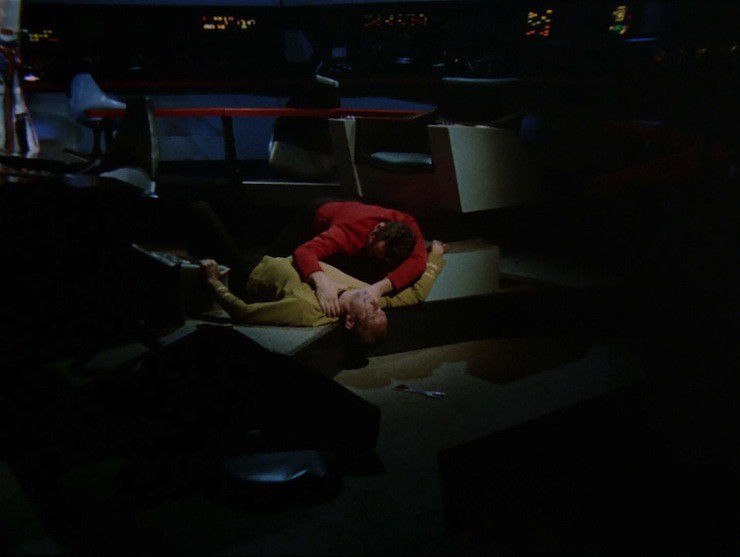
Spock says there has been no reported mutiny on a starship ever before, having apparently forgotten his own mutiny in “The Menagerie.” The captain’s neck has been broken. Spock finds absolutely no signs of life on board. Kirk sends Chekov to engineering and McCoy to sickbay, and both of them find more corpses, all having died violently. Chekov starts feeling a little woobly as he leaves engineering. McCoy asserts that they all killed each other—and the doctor’s hand passes through both a corpse and a table.
On the Enterprise, Sulu has to course correct, as the Defiant keeps drifting, and he’s having trouble getting a lock on it. O’Neil can’t get a transporter lock on the landing party, either, and Scotty has to deal with it himself—however, he can only transport three at a time, and it’s touch and go at that. He manages to get Spock, McCoy, and Chekov on board, barely, but by the time they materialize, the Defiant has completely disappeared—with Kirk still on board. (Cue dramatic music.)
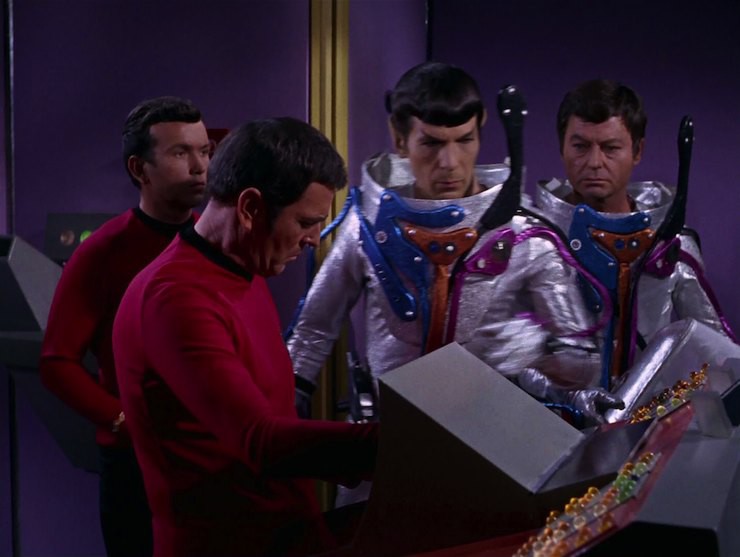
Spock’s data indicates that there is an interphasic rift into which the Defiant has fallen, and the computer says it will be two hours before the Defiant will reappear. On the one hand, the weak fabric of space means they can’t leave without making things worse for the Defiant; on the other, this area of space seems to be having a deleterious effect on the ship’s systems, not to mention whatever caused the Defiant crew to go binky-bonkers.
Speaking of that, Chekov goes nuts, attacking Spock with the same murderous fury that apparently affected the Defiant crew. Sulu, McCoy, and Scotty have to restrain him until Spock neck pinches him. Security takes him to sickbay and McCoy orders restraints. He needs time to isolate the cause of the insanity, and he advises moving away from this area of space, but Spock can’t without risking damaging space enough to lose the Defiant. McCoy is also attacked by one of his medtechs.
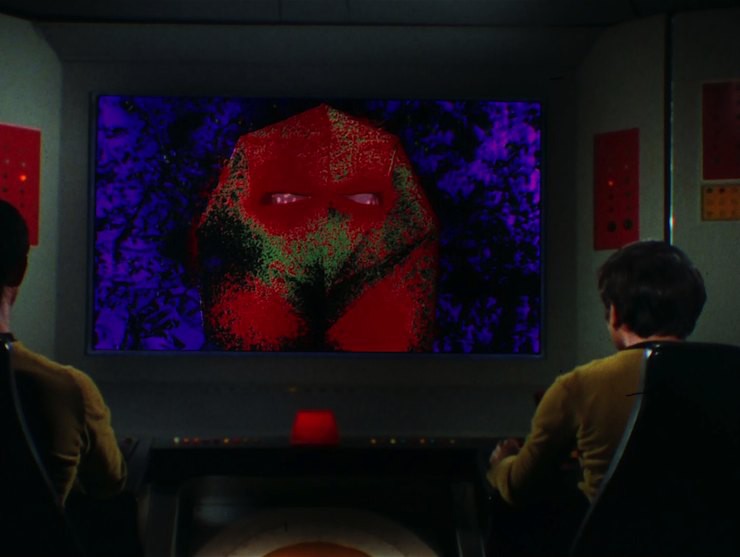
A ship approaches belonging to the Tholian Assembly, whose commander, Loskene, accuses them of invading their space. Spock replies that they’re in free space and are attempting to rescue another ship. Loskene detects no other ship (and insists that this is Tholian territory), but is willing to give Spock the two hours says he needs for the Defiant to reappear.
Unfortunately, the Tholians’ entry into this space has changed the interphase pattern, so they cannot beam Kirk over. Even more unfortunately, McCoy reports that it’s this region of space that’s causing the nutsiness and they have to get out of there.
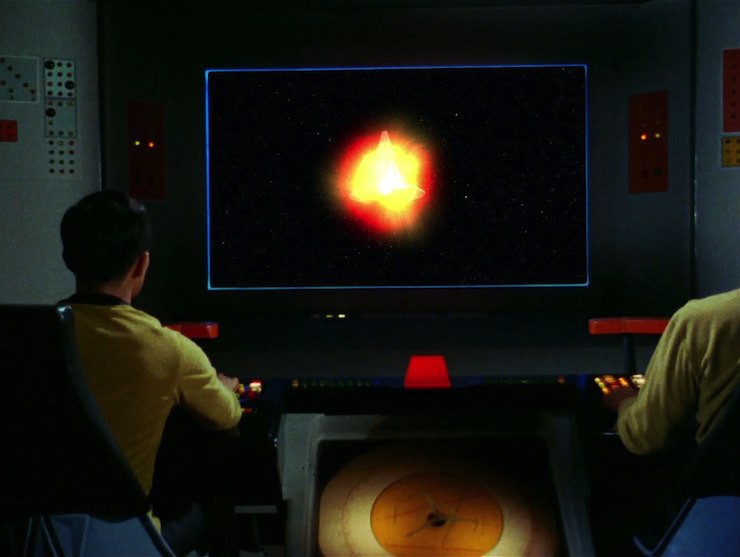
The Tholians fire on the Enterprise right when the two hours have passed. Their weapons fire damages the Enterprise sufficiently that the ship is now drifting. However, return fire does stop Loskene from pressing the attack.
Another Tholian ship arrives, and links up with Loskene’s ship. They then separate, a strand of energy between them. The ships are weaving a web around the ship, and with the Enterprise adrift, there’s nothing Spock can do.
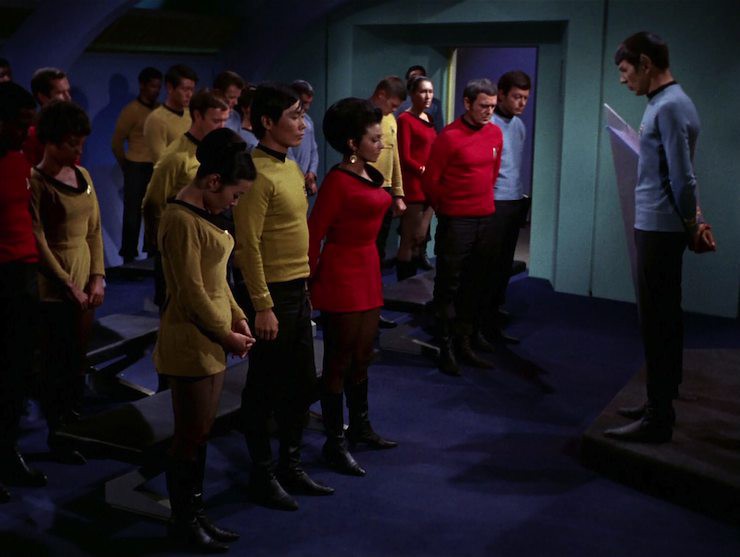
Spock holds a service for Kirk in the ship’s chapel. In the midst of the service, another crew member goes batshit, and McCoy has him brought to sickbay.
Kirk left a message for Spock and McCoy to play in case he was declared dead. Both Spock and McCoy snipe at each other, with McCoy bitching Spock out for trapping them in this area of space for sentiment, or perhaps to make sure that Kirk was really dead so he could take command. Spock, meanwhile, needs McCoy to practically put him in a headlock to obey Kirk’s last wishes.
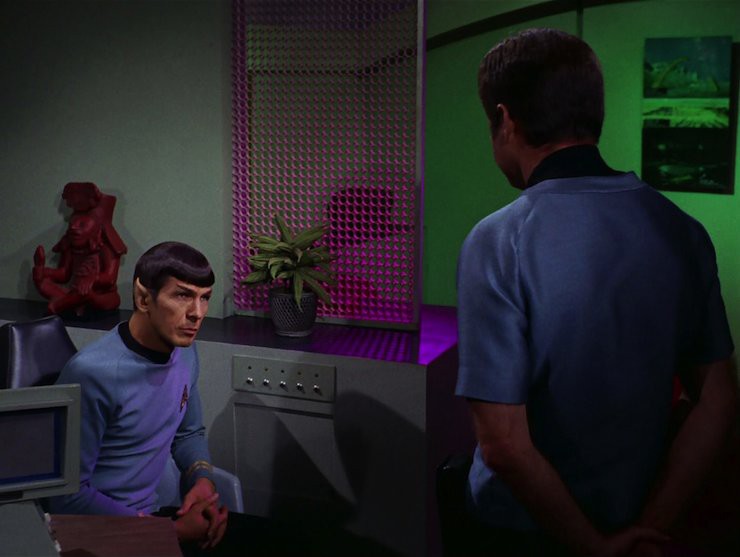
They play the recording. Kirk urges Spock to temper his logic with intuitive insight—and if he can’t do that, to go to McCoy for help. He also urges McCoy to advise Spock, but also to remember that he’s the captain now and the doctor should follow his orders and inspire the same confidence that they had in Kirk.
Abashed, McCoy apologizes, and Spock—well, he is less harsh with McCoy, at the very least.
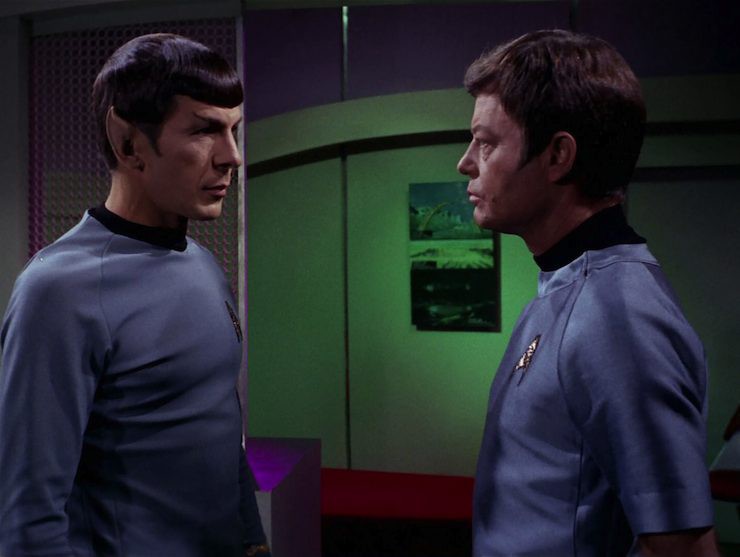
We cut to Uhura in her quarters, preparing for bed, when she feels a sharp pain in her stomach—and sees Kirk in her mirror! He looks like he’s in pain and crying for help, and then he fades away. Uhura immediately runs into the corridor and bumps into McCoy, insisting that she saw Kirk, but she’s also in bad shape from the looniness.
One of Scotty’s engineers goes nuts and attacks Scotty and some others. They take him to sickbay, where McCoy and Chapel are getting closer to a cure, at least. Then Scotty also sees Kirk, just like Uhura did. And then, after McCoy starts to lose it on the bridge, Kirk shows up there, too, where the whole bridge crew can see him.
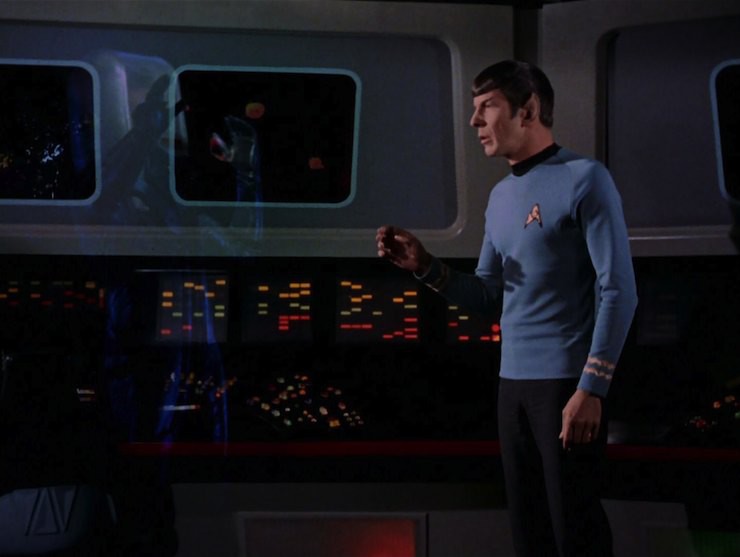
McCoy releases Uhura from sickbay, since she’s not crazy, and that’s followed by news that he’s found a cure: a diluted form of theragen, a Klingon nerve gas, mixed with alcohol. It deadens certain parts of the brain, which Scotty insists that any good Scotch can do. (That explains why Scotty’s unaffected—he’s already soused most of the time.)
The ship goes into interphase just as the Tholians close their web, with the Enterprise going through interphase to escape the web. Kirk appears twice on the viewscreen, and O’Neil manages to lock onto him and beam him safely aboard.
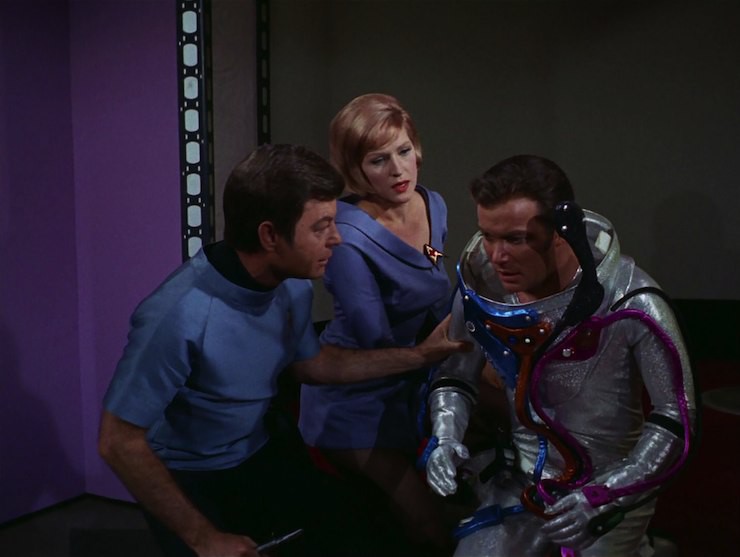
Kirk reports that the Defiant disappeared after the Tholians fired, leaving him completely alone in the strange other universe. He’s grateful for the rescue as he prefers a crowded universe. Spock and McCoy then lie through their teeth and say they never watched Kirk’s final orders to them, apparently preferring to let Kirk think that they got along fine without his advice forcing them to reconcile.
Can’t we just reverse the polarity? The region of space the Defiant was lost in is fraying like an old tapestry (because that’s totally how space works) and it does unfortunate things to the human brain.
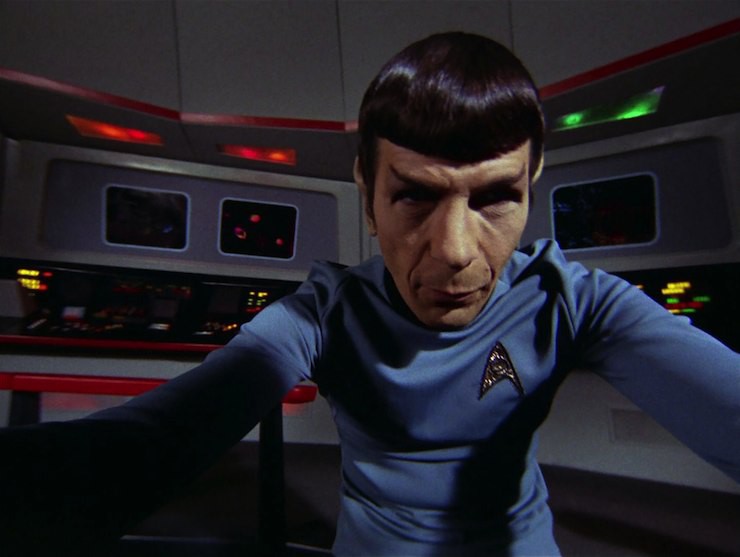
Fascinating. Spock does everything he can to save the captain, even though it risks the whole crew. His rationale is that Kirk would do the same for a member of his crew, which McCoy agrees with, so you wonder why he’s giving Spock shit about it.
I’m a doctor not an escalator. McCoy finds a cure for the interphasic insanity. Because he’s just that awesome.
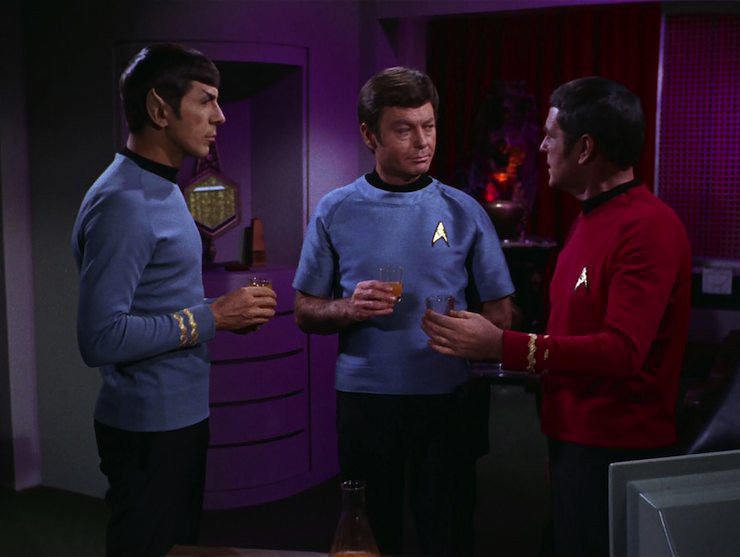
Ahead warp one, aye. Sulu flies the ship, on those rare occasions when the ship is able to move, and that’s it. He doesn’t get to do any repairs or calculate any trajectories or do any other fun stuff (that’s all Scotty), he doesn’t get to do any science stuff (that’s all Spock and McCoy), he doesn’t get to see Kirk’s silent image (at least not until everyone does, prior to that it’s Uhura and Scotty), and he doesn’t get to go binky-bonkers (that’s just Chekov and a bunch of supernumeraries).
Hailing frequencies open. It’s a good thing Uhura doubled over in pain before seeing Kirk, because otherwise there was no justification for putting her in sickbay after that. As it is, her entire reaction was appallingly close to stereotypical hysterical behavior because she’s just a girrrrrrrrrrrrrl.
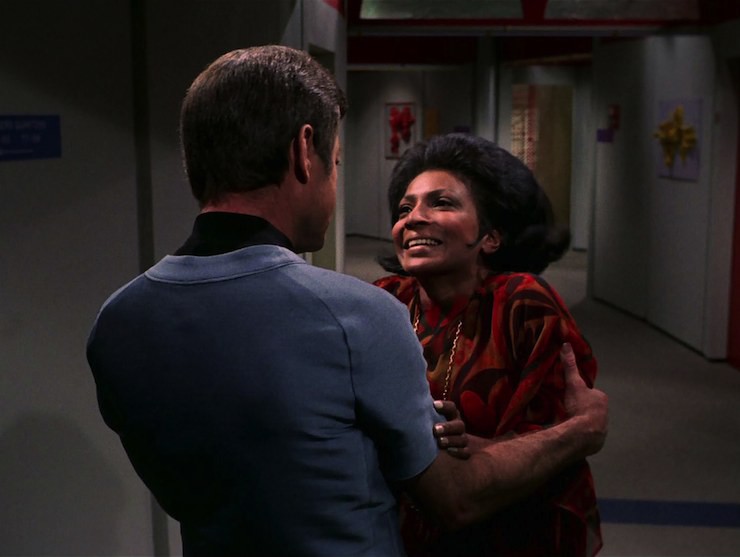
However, it is cool to see her in civvies.
It is a Russian invention. Walter Koenig gets to do what he does best: scream. He screams on the bridge and he screams in sickbay.

I cannot change the laws of physics! Scotty gets to fix everything that’s broken and save the day. He rewards himself by wandering off with McCoy’s theragen-and-alcohol cure to get swozzled. In fact, it’s left to O’Neil to beam the captain back on board, since Scotty is presumably off on a bender somewhere…
Go put on a red shirt. A couple of redshirts go nuts, but at least they all survive!
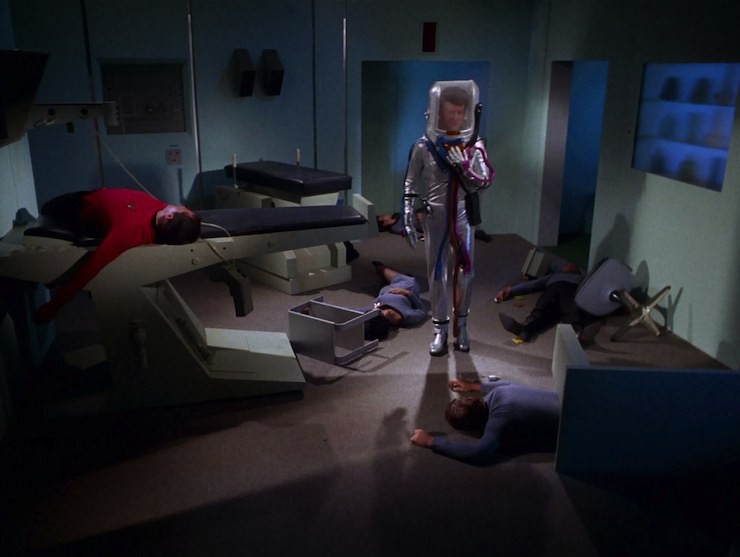
Channel open. “One good slug of this, and you can hit a man with a phaser stun, and he’d never feel it or even know it.”
“Does it make a good mix with Scotch?”
“It should.”
“I’ll let you know.”
McCoy and Scotty discussing the finer points of the antidote, with Scotty wandering off to enact what will be his next share at his AA meeting.

Welcome aboard. All the billed guests in this one were recurring or returning characters: Sean Morgan reprises his role of O’Neil from “The Return of the Archons,” alongside regulars George Takei, Nichelle Nichols, James Doohan, Walter Koenig, and Majel Barrett.
Barbara Babcock does an uncredited turn as the voice of Loskene. Previously, Babcock did the voices of Trelane’s mother in “The Squire of Gothos,” and both the Beta 5 computer and Isis in “Assignment: Earth.” She also played Mea 3 in “A Taste of Armageddon,” and will return in “Plato’s Stepchildren” as Philana and do the voice of Zetar in “The Lights of Zetar.”
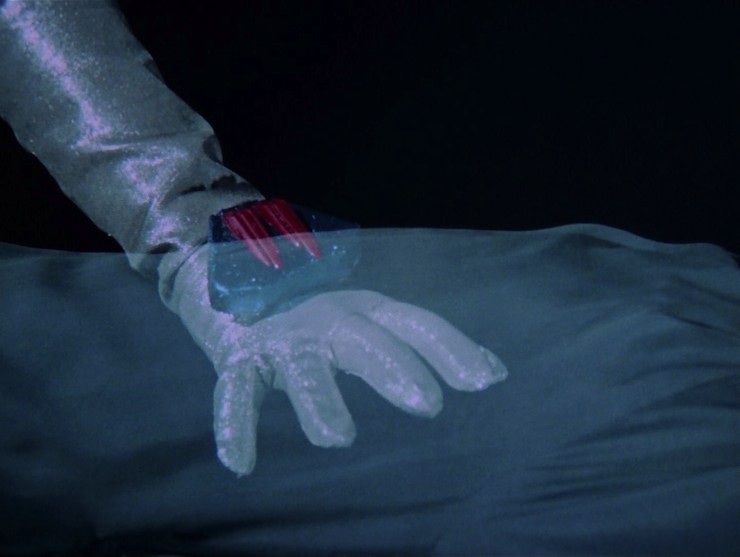
Trivial matters: This episode was mostly directed by Ralph Senensky, but he was fired most of the way through for going over schedule and was replaced with Herb Wallerstein, who received sole credit, even though most of the footage was shot by Senensky. According to Senensky’s account on his blog in 2010, the schedule overrun was not his fault, but due to the environment suits not being completed in a timely manner.
The final fate of the Defiant will be revealed in the Enterprise two-parter “In a Mirror, Darkly,” where it is discovered that it went through the interphasic rift into the Mirror Universe (from “Mirror, Mirror” and a mess of DS9 episodes) a century previous, where it’s found by the MU version of Jonathan Archer.
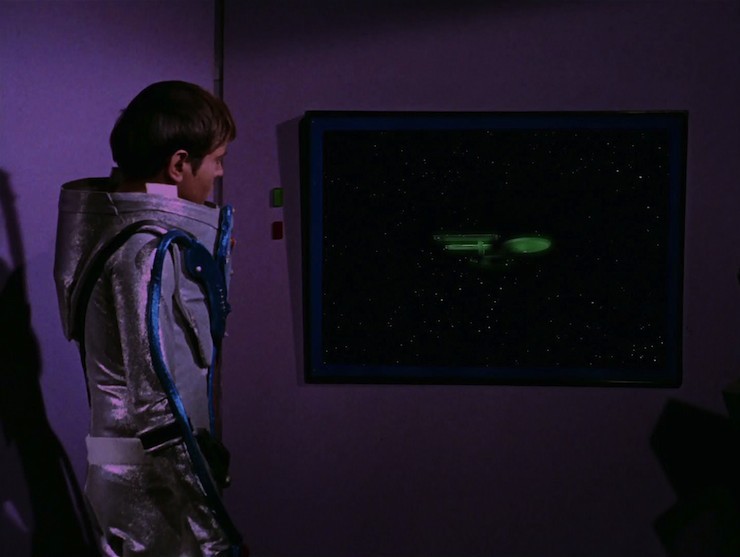
Four years prior to that Enterprise story being produced, Dayton Ward & Kevin Dilmore wrote a two–part Starfleet Corps of Engineers story called Interphase in which the U.S.S. da Vinci retrieved the Defiant from the interphasic rift, which also revealed what the Defiant was doing in the sector and why the Tholians were so antsy about it. After “In a Mirror, Darkly” aired, Ward had been ruminating on a plot that would reconcile the two, but the S.C.E. series was cancelled so the opportunity to write it never presented itself.
The Tholians will continue to be mentioned throughout TNG (e.g., “The Icarus Factor,” “Reunion“) and DS9 (e.g., “The Way of the Warrior,” “Call to Arms“), but will not be actually seen again until Enterprise‘s “Future Tense” and “In a Mirror, Darkly.”
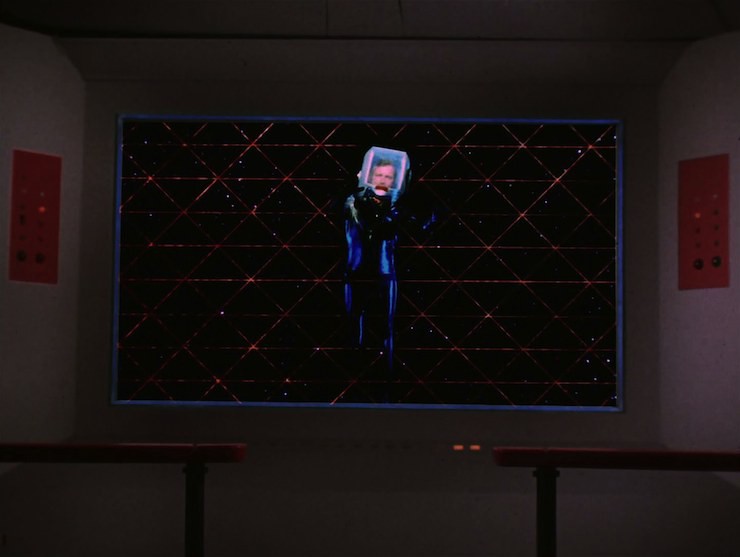
In the tie-in fiction, the Tholian Assembly is one of the primary antagonists of the Vanguard series by David Mack, Ward, and Dilmore (including a certain amount of backstory for this episode), and the Assembly also becomes a major player in the Typhon Pact starting in your humble rewatcher’s A Singular Destiny and seen in many subsequent novels.
Among the many other appearances by the Tholians in the tie-in fiction besides those listed above: the Destiny trilogy by Mack; issues #71-75 of DC’s second monthly TNG comic book series written by Michael Jan Friedman; the IDW one-shot Captain’s Log: Sulu written by Scott & David Tipton; the Lost Era novel The Sundered by Andy Mangels & Michael A. Martin; the TNG novel Vendetta by Peter David; issues #10 & 11 of the comic book series Star Trek: The Early Voyages written by Dan Abnett & Ian Edginton; the short story “Fracture” by Jeff Bond in the original series anthology Constellations; etc. The Tholians are also part of the games Klingon Academy, the Decipher role-playing game module Aliens, and Star Trek Online. Finally, a version of this story in the alternate timeline of the 2009 film and Star Trek Into Darkness was done in issues #46-47 of IDW’s monthly Star Trek comic written by Mike Johnson.
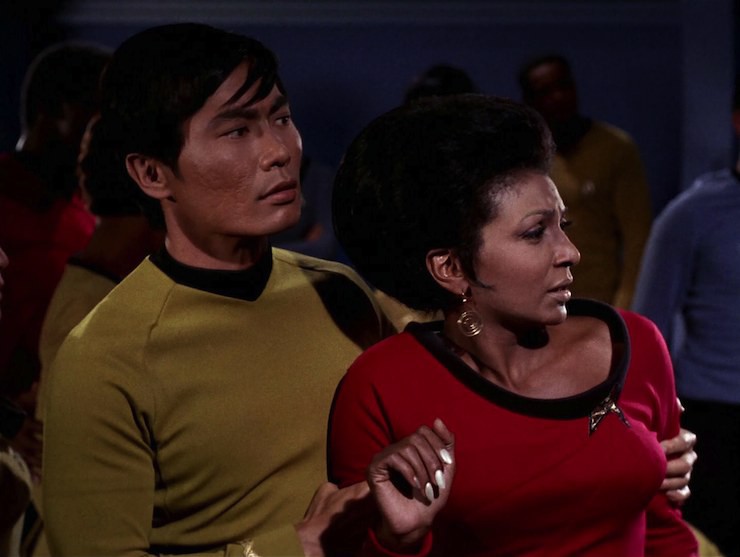
This is the second time we see the ship’s chapel, previously seen in “Balance of Terror.”
This episode debuts the new environment suits, which look much better than the shower-curtain rejects from “The Naked Time.” They’ll be seen again in “Whom Gods Destroy.”
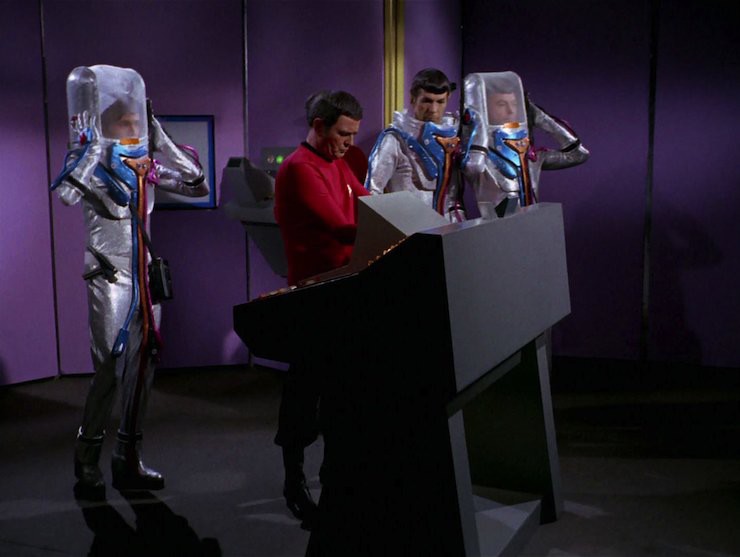
The special effects from this episode got the show nominated for an Emmy award for Outstanding Achievement in Art Direction and Scenic Design, losing to Mission: Impossible.
To boldly go. “He’s alive, Doctor!” This was always one of my favorite episodes as a kid, so it was really disappointing to sit and watch it now and see all its flaws.
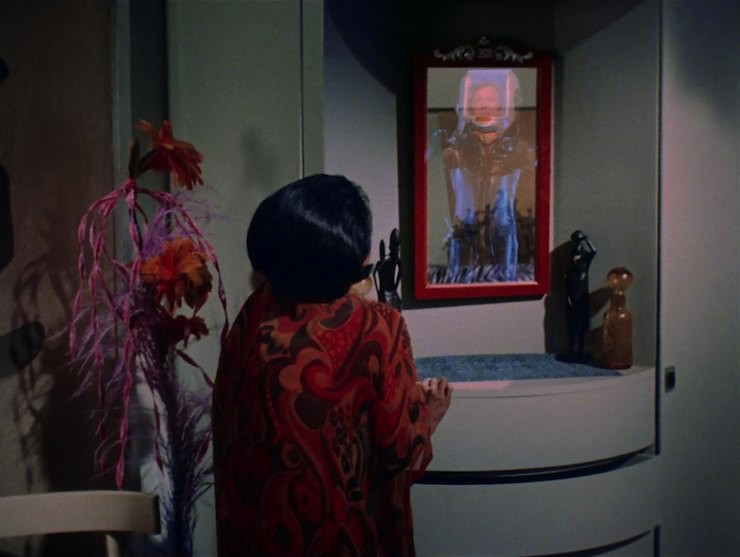
Not that they change this into a bad episode. In fact, by the low standards of the third season, it’s quite good. Parts of it are superb. The eerie atmosphere of the Defiant in the first act is very effective. Watching as crewmember after crewmember succumbs is likewise, with the added bonus of Chekov—someone we actually know and care about—being our first victim. (Plus there’s no better screamer this side of Fay Wray than Walter Koenig.) It’s nice to see Uhura in her quarters off duty, it’s nice to see an actual acknowledgment of other crewmembers (even if it is only long enough for them to go batshit or to be extras in the service), and it’s nice to see Kirk delivering one last bitch-slap to his best friends to stop being morons from beyond the not-really-his-grave.
Best of all is another set of aliens like the Melkotians and the Medusans who appear to be truly alien, not just people in suits/makeup. Loskene’s bizarre appearance combined with Barbara Babcock’s filtered voice make for a very compelling antagonist.
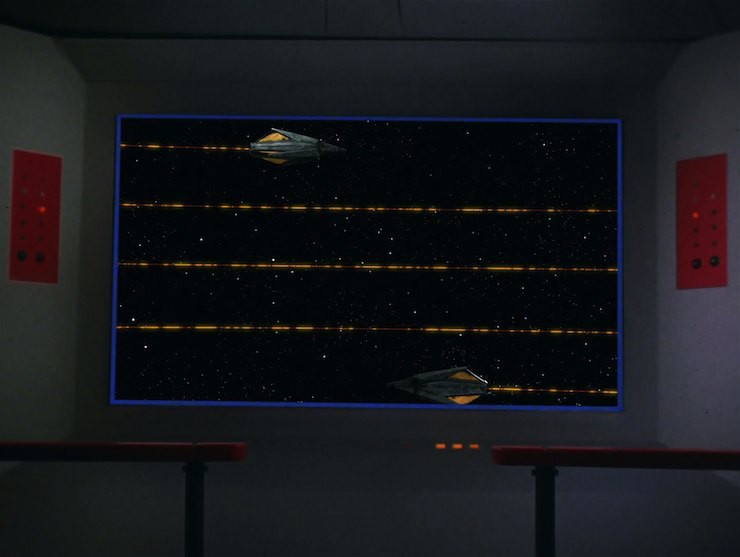
Unfortunately, that’s the primary problem with the episode: the Tholians are introduced as this grave threat, who then weave the slowest web in history (how do they entrap ships that aren’t crippled, one wonders?), and then are irrelevant to the rest of the episode. Aside from a nifty visual of the Enterprise being entangled in an energy web for establishing shots, the Tholians barely register as even existing once we get past their initial appearance.
Also the Spock-McCoy sniping feels a bit too constructed. Part of the problem is that McCoy is a moving target: Is he criticizing Spock for being too human in going after Kirk? Isn’t that what he always wants Spock to be? Then he’s accusing him of staying to make sure Kirk is dead so he can have command, which McCoy knows is nonsense—but it’s there to create extra suspense. Some of this we can chalk up to grief and McCoy fighting off the effects of the looniness, but still, it just feels off from the usual.
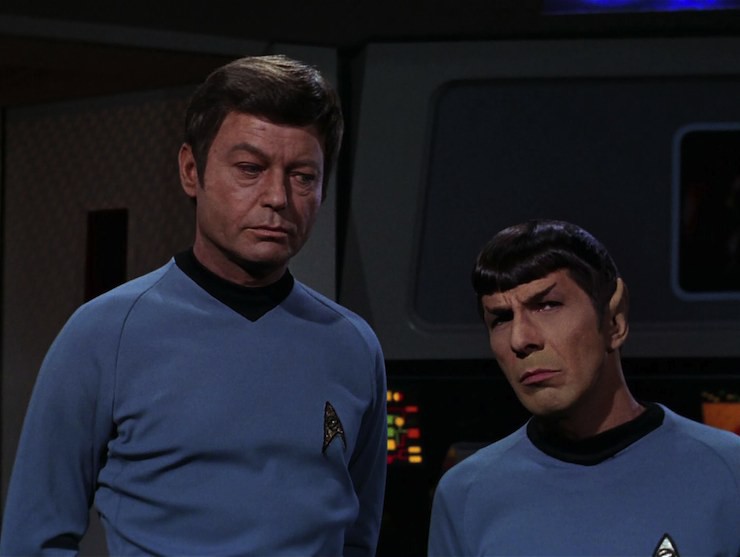
Ultimately, though, despite the flaws, the episode works because there is genuine tension—with the fate of the Defiant crew hanging over everyone as a possible outcome—and because it gives the rest of the crew a chance to take the spotlight and see how they function without their captain. Mostly it shows up how important Kirk is to the dynamic, since the crew is discombobulated without him, though they eventually suck it up and get it done.
Warp factor rating: 6
Next week: “For the World is Hollow and I Have Touched the Sky”
Rewatcher’s note: Due to the Independence Day holiday, there will be no Original Series Rewatch on Tuesday the 5th of July. (Yes, it’s past the actual holiday on the 4th, but your humble rewatcher is spending the preceding weekend at a convention and then the days after it with family.) We’ll be back on track with “For the World is Hollow and This Title is Too Damn Long” on the 12th.
Keith R.A. DeCandido will be at InConJunction XXXVI this weekend in Indianapolis as a Special Guest, alongside media guest of honor Rockne S. O’Bannon (creator of Farscape, among other things), author GoH Simon Morden, artist GoH Heather V. Kreiter, music GoH Wax Chaotic, and tons more. He will be signing and selling his books at the show, and also doing programming: his full schedule, including a Farscape panel with O’Bannon, is here.










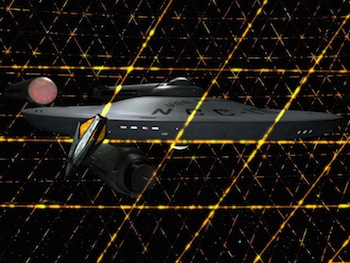
It’s always been a bit amusing to me that Kirk had the foresight to record a tape that is completely on point to their fairly specific situation (Kirk dead, Spock/McCoy alive but engaged in some form of conflict, ship in tactical danger but with enough time to actually listen to the tape). I like to think he had dozens of these for the various iterations of possible things that could go wrong– i.e., one for Scotty in case all three of Kirk/McCoy/Spock died on an away mission, one for McCoy if he and Spock died, one for Spock if he and McCoy died, one for Chekov in case everybody else dies and there’s nobody else left to be in charge, etc.
This sounds like a mash of two separate episodes: one with hostile aliens getting upset about trespassing and one about a derelict ship in space and the crew going crazy. Maybe they stuck them together so it felt more original?
Despite the flaws, this is my favourite third season episode.
It’s nice to see the large number of crewmembers in the chapel, I love the scene where McCoy releases Uhura from sickbay, and also the Spock-McCoy dynamic. Although this was the episode that made me wonder if McCoy even likes Spock, so I agree that it feels a bit off.
I also love the final scene. The way I see it, Kirk knows exactly that his friends are lying, and they know that he knows, but they all decide not to mention it. Sometimes the light-hearted joking in the final scene is inappropriate or silly, but here it’s perfect.
I’ve always liked this episode, but it’s true, the Tholians end up not being really much of a threat.
This is one time that I can’t add much to Keith’s comments, since I agree with his assessment about most of it. Except one thing — I really hate the weird-as-hell spacesuit design here. It’s not just garish, but it makes no design sense. Why is the top of the helmet transparent but not the sides? How is it remotely useful to have the transparent area actually perpendicular to the wearer’s range of vision? And where the hell are the air tanks? And what’s with all the exposed conduits on the outside where they can be easily damaged? Real-life spacesuits have to be designed to withstand micrometeorite strikes — they’re actually bulletproof. That was true even in 1968. And yet these supposedly futuristic 23rd-century suits look more fragile and poorly designed than what NASA was actually using at the time the episode was made.
But I definitely agree about the uselessness of the Web as a capture tactic for a ship that isn’t already immobilized. I’ve never cared for all the sequel comics and stories that portrayed the Web as some terrifying superweapon. It’s far too slow and clumsy for that. I’ve always assumed it was just some cargo-hauling tech that was repurposed to hold the Enterprise in that particular situation. Although I guess that idea is scuttled by “In a Mirror, Darkly,” since that showed the Web as a much faster-acting combat system in the Mirror Universe.
As for the discrepancy between the SCE story and IaMD, I think the explanation must be that the IaMD Defiant came from a slightly parallel timeline. After all, look at the shot of the Defiant sickbay up above, under “Go put on a red shirt.” The redshirt on the left clearly has the same arrowhead insignia as the Enterprise, reflecting Roddenberry and Justman’s preference that it be used for all vessels of that class (despite what “The Doomsday Machine” and “The Omega Glory” had shown). And yet the Defiant uniforms in IaMD used a different insignia, based on the “boomerang” Starfleet Command insignia seen in the “racing stripes” on the side of the Enterprise and the shuttlecraft, and on the wall behind various admirals. So maybe the interphase rift is like the quantum fissure in TNG: “Parallels,” overlapping multiple alternate timelines that vary only in the slightest details. So there was more than one Defiant that got caught in the rift, allowing both stories to happen.
Oh, Keith, one additional Tholian appearance was in the novel The Lost Years: Recovery by J. M. Dillard. That one had an unusual interpretation of the Tholians, assuming the shape we saw on the viewscreen was a helmet worn by a soft-bodied, tentacled creature, unlike the usual interpretation of the Tholians as crystalline beings. There were a variety of different Tholian anatomies proposed before IaMD settled the question. The DC comics storyline portrayed them as just blocky humanoids made of crystal. The Sundered described them as having scorpionlike bodies. The Worlds of the Federation by Shane (now Lora) Johnson showed them as just levitating, limbless spindle-shaped creatures.
Christopher: Oh, I know I didn’t mention all the Tholian appearances in the tie-in fiction. That’s why I said “Among.” :)
—Keith R.A. DeCandido
I’ve never really understood why so much of fandom seems to have found the Tholians so compelling, I particular their weird webs. Having no humanoid aliens is cool and all, but I just can’t get over how enormously impractical the Tholians Web is. I mean, who invented that technology? And why? And who decided to build it into their ships? This episode probably marks the only circumstance in all of Tholians history where it was even a viable option….
Anyway, I’ve been reading a lot of these researched for a long time, but today marks the first time I am able to comment on them LIVE. As such, I’d like to say a few things.
First: Keith R.A. DeCandido and Christopher L. Bennet: I love both of your work. With most TrekLit books, I wait for reviews before I buy. With the two of you, I pre-order as soon as the listings go live on Amazon.
Second: I’m really loving the Rise of the Federation series, and hope it never ends.
Third: What happened with the IKS Gorkon/Klingon Empire books? Please don’t tell me the series is dead–not one of my favorites.
Arsene: Thanks for the kind words! Keep in mind that the Tholians also have conventional weapons, which is what they used initially. They didn’t go for the web until after the Big E fired back and damaged Loskene’s ship.
I’m glad you like my work — I hope you mean all my work, not just my Trek work, since I’ve written a ton of other stuff, and I don’t have any new Trek work on the horizon. Related to that, yes, the Klingon Empire series was over and done with A Burning House. We were hoping the rebranding would goose sales (Enemy Territory, the third I.K.S. Gorkon book, performed very poorly), and it did, but it wasn’t enough to justify doing more.
—Keith R.A. DeCandido
I’ve read somewhere (don’t remember where) that the time it takes to weave a Tholian Web may depend on the number of available ships. If this theory is true, the web could indeed be a practical and even formidable weapon when deployed by three or more ships.
I like this idea alot. Not only it explains away all the inconsistencies, but it also hints at some seriously alien psychology at work: Why is the Tholian signature weapon so dependent on team work? It feels “wrong” from a human perspective, which is exactly what makes the entire concept so fascinating.
Isn’t that what they call it when you are convinced of something, but can’t give any rational justification of it? Is that really something a starship captain needs more of?
“with Scotty wandering off to enact what will be his next share at his AA meeting.”
As one who has been sober for 22 years, reading this while waiting to set up my AA meeting, I loled. Literally. Got an odd look, too.
Hope Scotty isn’t one of those who is always getting sober over and over. That’s never good.
@krad: This a shame bout the Klingon books. I only got back into TrekLit for the first time since childhood a few years ago, after the last book came out, so maybe I’m partly to blame for the poor sales. Those books are, however, amount g the first I recommend to fellow fans.
Most of your stuff I’ve read is TrekLit, though I’ve also dug I to the Dragon Precinct stuff and find those to be a lot of fun. Unfortunately I’ve only read Bennet’s Trek work. I wonder, how hard is it to transition. From writing licensed fiction versus original fiction? Do you feel less pressure re: setting consistency since you are responsible for everything, or more pressure due to the lack of handy resources like Memory Alpha?
@Arsene Lupin: Thanks for your kind words on Rise of the Federation. As for “transitioning,” I actually wrote original fiction first, although I only managed to sell two novelettes to Analog Science Fiction and Fact before I started doing Trek. I always hoped that the majority of my published work would be original with Trek as an ongoing sidebar, though it hasn’t worked out that way (I’m still trying, though).
It’s certainly easier to keep a universe consistent when you’re the only one writing it, although some mistakes will slip through regardless, and sometimes you might choose to retcon things on purpose when you get a better idea or recognize a mistake.
One of my favourites due to the alien quality of the Tholians, the fact that Chekov got to do some science stuff AND get off the ship and some great McCoy moments. A nice part of it too is how it gets the crew a chance to shine with a minimum of Kirk. I like Kirk but as time went on he took more and more of the spotlight. It’s a breath of fresh air to see that the crew is competent even without JTK leading the way.
On the downside, Chekov goes loudly nuts and is confined to sickbay (rightly so) but Uhura shows no such behavior, just a general confusion (exaggerated due to her being a woman in a 1960’s TV show) and she’s also locked up. Doesn’t anyone else notice that she’s not acting at all like the other people that are losing their marbles? Apparently not.
The environmental suits are over designed to a degree but I still like them. Of course, the reason the helmets are not clear on the sides is because the front visor is actually a mesh much like widow screen that wouldn’t hold a curve. No need to worry that your actors need an air supply and there’s still enough substance to the visor to make it obvious that there’s something there. Classic Trek design and I was slightly disappointed in the design of the suits in TMP and TWOK in that they looked too much like current day suits and didn’t borrow any of the design cues from these ones. Not saying that they needed to be updated copies but rather that they looked like something that evolved from the older designs. As far as being proof against micrometeorites, they’re from the future. I’m sure they handle those and radiation and the like just fine.
Again though, we have the Federation wandering into someone else’s space and acting all put out that someone there might take offence to it. After all, the Federation is peaceful and if you don’t believe it they’ll just go all General Order 24 on your ass.
A high point of the third season and one that wouldn’t have been out of place in an earlier season. I give it a solid 7, maybe 7 1/2.
@14/kkozoriz: The point is, a design that micrometeorite-proof would probably have its supply hoses inside the protective skin instead of outside. Really, having all those tubes out on the surface runs contrary to the usual minimalist design philosophy of TOS. Here’s a video Doug Drexler just posted of Matt Jefferies talking about the Enterprise and his time on Star Trek. Jefferies explained that he wanted the ship’s hull to be smooth and not covered in greebly details like on 2001‘s miniatures because he thought it made more sense to design the ship in a way that all its components could be repaired from inside the ship, rather than requiring dangerous EVAs to do it. The same design philosophy would call for putting the air and other supply tubes on the inside of a spacesuit instead of the outside, rather than illogically putting them in an exposed and vulnerable position just for the sake of aesthetic detail.
“Again though, we have the Federation wandering into someone else’s space and acting all put out that someone there might take offence to it.”
The episode states quite clearly that the space was unsurveyed and unclaimed as far as the Federation was aware. There was no deliberate trespass. Indeed, given the conditions of interphase space, the Defiant might have drifted or been pulled to the position where it was found.
15. ChristopherLBennett – However, if you did put the tubing on the inside then you’d have a plain silver suit not unlike what was used on Lost in Space. And if they’re made of the same stuff as the skin of the suit then the tubes are just as tough as the rest of it. Also, having them outside where they can be worked on if something goes wrong instead of being inaccessible inside the suit. “Gee Bob, I’d love to fix that problem with your air recycler. How long can your survive in a vacuum so I get get inside your suit?”
Or, much like in Arena, the Federation knew that someone was there and just blundered in without thinking of the consequences. The US doesn’t recognize the Chinese claims in the Suoth China Sea but that doesn’t mean it’s a good idea to send two of your most powerful warships to the area.
kkozoriz: I realize this spoils your consistent anti-Federation narrative, but in “Arena” the Federation had no idea that the Gorn claimed the planet, and Spock specifically says that the region they’re in is free space according to the Federation. They’re obviously aware of the Tholians’ existence, viz. Spock’s comment about their rep for punctuality, but that they were also surprised to see them there means that the Tholians kept their interest in that area of space a secret. (Interphase, for all that it was shitcanned by “In a Mirror, Darkly,” addressed this rather nicely.)
—Keith R.A. DeCandido
I like the non-remastered Tholians better.
Are these space suits or environmental suits?
RAH had some notions on spacesuit construction and design in, of course, Have Space Suit: WIll Travel. I assume almost everyone here has read it :)
kkozoriz @@@@@ 16- I know of no nation that recognizes the PRC’s claims in the South China Sea, especially the artificial islands. And the USA will, as always, exercise freedom of the seas rights. Especially when abandoning such transits effectively cedes control to bullies.
17. krad Or, as I suggested, the Federation simply didn’t recognize their right to claim it.
And I wouldn’t call myself anti-Federation. Rather, I recognize the fact that the Federation is not perfect, regardless of their propaganda. They’ve made may mistakes but most people tend to gloss over them.
In Arena, Spock mentions that there’s rumours that there’s someone in the area. They just don’t know who. So their response is to build an armed outpost and load it with military (Starfleet) personnel and their families. That’s not a “We’re just here to support a scouting mission type of installation. That’s a “We’re here to put down roots” sort of place. I was rather disappointed to learn that the Federation had kept the planet when DS9 addressed the issue. I’d prefer to see one of the other parties come out on top for a change.
Probably comes from being a non-American, looking in from the outside. My perspective is a bit different than most of the Federation (ie-USA)situation.
18. sps49 – My Federation right or wrong? The UFP certain;y had no problem getting involved with Eminiar VIII, where they were specially told to stay out by Code 710.
KIRK: Code seven-ten means under no circumstances are we to approach that planet. No circumstances what so ever.
FOX: You will disregard that signal, Captain.
KIRK: Mister Fox, it is their planet.
FOX: Captain, in the past twenty years, thousands of lives have been lost in this quadrant. Lives that could have been saved if the Federation had a treaty port here. We mean to have that port and I’m here to get it.
The Federation is perfectly capable of being a bully too
Re: the silly space suits.
Ignoring the weird helmets, wouldn’t it be *logical* to have all the machinery easily accessible and out in the open, rather than hidden behind layers of armor? Assuming, of course, that they can use energy fields to defend against micrometeors and the like?
This vies with Mirror, Mirror as my favourite Trek episode and it is precisely because I, being a McCoy fan as well as one of the Spock-McCoy relationship, was thrilled (as the impressionable teenager I was then, and as some believe I still am) to see them (and the crew) deal with tragedy, danger and relationships without Kirk.
I am not a scientist but suspect that the Tholians might be mighty pissed as the Enterprise crew has defied and deceived them, which they claim not to tolerate, but do not engage in pursuit of said violators.
And why was Uhura shaking or fainting because she saw Kirk? And please DO NOT tell me because she is merely a woman or I will break out my phaser and go postal on your nether regions.
I had heard of Keith but (before this blog) not of Chris Bennett—or else it has been so long since I have read any Trek books, that I have completely forgotten. (To be fair, it has been a while since I have performed my variety show at any convention so it’s possible that people don’t remember me in the same way either.)
I am still trying to catch up on the rewatch but I figured that at least I can contribute to the current episode and maybe for the rest of the series since I (unlike most) actually love the third season. Or at least I DID….
@19/kkozoriz:
I don’t know about that. A lot of people here are non-American. I’m from Germany.
Anyway, I think most people here would agree that the Federation is not perfect. What makes your position stand out is that when in doubt, you usually go for the least benevolent interpretation. What you say about Arena is a good example – all we know from the episode is that there is an “Earth observation outpost” at the outskirts of known space and that “there are rumours of certain strange signals on subspace channels”.
This is what you wrote:
But really, we don’t know any of that. First, they don’t know that there’s someone in the area. Rumours of strange signals are as unspecific as you can get. Perhaps there’s nobody there. Second, you don’t know that the building of the outpost is their response. Maybe they built the outpost first, and the rumours started later. Third, we don’t know how long the output has been there and if it was planned as a “we’re here to put down roots” sort of place. Maybe it started as a scouting mission, and when all went well, people wanted to bring their families too. What we do know is that they were visited by ships they didn’t know “now and then. They’re all welcome to use our facilities.” That doesn’t sound particularly imperialist to me.
You’re free to make up any backstory you like, and you go for one that makes the Federation look bad. That does look a bit anti-Federation at times.
A little something for krad and CLB to chew on: Fade In: From Idea to Final Draft – The Writing of Star Trek: Insurrection
I need to find a copy of this…
@20/Arsene Lupin: “Ignoring the weird helmets, wouldn’t it be *logical* to have all the machinery easily accessible and out in the open, rather than hidden behind layers of armor? Assuming, of course, that they can use energy fields to defend against micrometeors and the like?”
The machinery, sure. But having the hoses just sitting loose on the surface like that, where they could easily snag on some loose bit of metal and get pulled out? That’s just stupid design, I don’t care how you rationalize it. Sure, you could handwave madly about superstrong materials and forcefields and all that, but it’s just trying to fix a design that’s bad to start with. If you just do a sensible design that keeps the pipes on the inside, then you don’t need all those clumsy rationalizations. The first rule of good engineering is to keep it simple.
And I hate the sci-fi cliche of using energy fields in place of solid surfaces, because it’s putting gratuitous “futuristic”-ness over sensible engineering. The problem with relying on a force field to protect your life or contain prisoners or whatever is that it has no safe failure mode. If the batteries die or a power circuit shorts out, you’re dead or your prisoners are free. That’s fundamentally inept engineering. A good design is one that still keeps you safe if something breaks. A solid surface is always better, because it won’t cease to exist if there’s a power interruption. (I hate the animated series’ force-field belts for this reason. Plus they have the same “where the hell’s the air tank?” problem that these suits have.)
Besides, as I said, it’s a matter of aesthetics. TOS’s consistent design philosophy was minimalist. These suits just look overcomplicated, and that’s aesthetically incongruous for the show. As much as I hate the force-field belts, at least they’re a better fit for the show’s aesthetics, because it’s hard to imagine a more minimalist spacesuit than that. (Except maybe this…)
22. JanaJansen – But I’m not saying that EVERYONE outside of the USA sees things that way. Some do, some don’t and some don’t care one way or the other. What I am doing is pointing out an alternative explanation for what we see. Playing devil’s advocate is you like. Maybe someone will have a “Gee, I never thought of it that way” moment. Trek, and TOS in particular, has been around for so long that people just assume that certain assumptions are the way things really are or must be. I’ve been a fan since the late ’60s and when I watch it now I’m always looking for a new perspective on it. It’s amazing how often something you assumed meant one thing can really mean another.
24. ChristopherLBennett – And I hate the sci-fi cliche of using energy fields in place of solid surfaces, because it’s putting gratuitous “futuristic”-ness over sensible engineering. The problem with relying on a force field to protect your life or contain prisoners or whatever is that it has no safe failure mode. If the batteries die or a power circuit shorts out, you’re dead or your prisoners are free. That’s fundamentally inept engineering. A good design is one that still keeps you safe if something breaks. A solid surface is always better, because it won’t cease to exist if there’s a power interruption.”
Then I guess you don’t accept the brig design or the shuttlebays from TMP forward or the EMH or…..
I secretly wished that the remastering would add a forcefield effect to the shuttle doors, much like the shuttlebays. Keep the air in while letting people move through. It was never going to happen but that’s my personal explanation why no Trek shuttles have anything resembling an airlock.
The shuttles in TOS did have outside access to machinery. We saw Spock working on it in Metamorphosis. By your way of thinking, that was also a mistake.
Matt Jeffries idea that you’d work on everything from inside works fine when someone actually has room to get to what they want to work on. Doesn’t work with a spacesuit. Could the hoses have been fastened down better? Sure, but the episode was already running late and the director was fired because of it. He has said that the main reason for the delays was the suits. I don’t think that they’d want to run even more behind and deal with the costs involved just to clear up a problem that doesn’t really exist. Just put it down to an imprecise visualization of what they were really like and enjoy the show.
As far as “Whee’s the air tank”, I imagine that there’s a small supplemental supply somewhere that’s stored under extreme pressure. Most of it would be taken care of through recycling the CO2. That’s what I imagine the black bit that stands up on the side of the helmet is for.
I have an easier time believing that the environmental suits work than I do for the warp drive, transporters or phasers. Now there’s some serious scientific implausibility. But I sit down to watch Star Trek, not Nova.
As space battle technology goes, the Tholian web is the equivalent of one of those slow-motion fights Laurel and Hardy used to have, when the up-end the tub of lard of some antagonist’s head, and he just lets them, because it’s their turn.
For all that we criticize the practicality of the Tholian web, I concede that it was a striking and imaginative visual, and a nifty special effect considering the budget limitations the show was under at this point. It’s one of those things that’s really cool when you first see it, but then kind of falls apart when fridge logic sets in afterward.
27. ChristopherLBennett – And isn’t that what Star Trek is all about? To entertain and inspire, not to instruct?
Agree with @27. The web was striking and memorable. And maybe back then we didn’t go in so much for fridge logic regarding TV shows. (And if we HAD, it’s hardly the first thing we’d look at in Star Trek.)
@29/Gerry Quinn: Fridge logic is, by definition, not the first thing you look at. It’s the afterthought you have at the commercial break when you’re going out to get something from the fridge — when the coolness of the moment fades and you get a chance to think back on it and go “Hey, wait a minute.”
And fans have always been questioning the logic of movies, shows, comics, etc. Look at any comic-book letter column from the ’60s and you’ll see lots of people writing in to complain about the logic holes or offer possible fixes for them. That’s why Marvel invented the No-Prize. I’m sure Star Trek fan letters were the same way.
Reading “Best of Trek” proves that pretty well. :P
And wasn’t that one of the big past times of the Baker Street Irregulars, resolving contradictions and logic errors and plot holes within and between Holmes stories as part of their effort at making them into a contiguous whole?
To me this episode is a classic case of heightened expectations. It wasn’t until recently that I saw this one, and everyone gave it the highest commendation. I went in expecting an episode on the same level or even better than Immunity Syndrome. Definitely a bit of letdown on that regard. To me, it feels worse because the Tholians are so underdeveloped that I can’t help but wonder how did they inspire so much work in tie-in fiction, plus their constant mentions in the Berman-era shows. In the Mirror Darkly is one of my favorite two-parters ever done. Tholian Web doesn’t even come close to those two shows.
Still, it’s a decent episode by season 3 standards. I’m actually impressed they came up with the concept of an interphasic rift. Supposedly, the original premise was a ghost story, an idea which Roddenberry nixed for it being too supernatural for Trek. Visually, the episode delivers, despite the web’s iffy logic.
Some of the Spock/McCoy conflict rings false on this one. As pointed out, Bones shouldn’t be giving Spock grief for responding emotionally, since that’s exactly what he wishes he would do. Don’t create conflict for conflict’s sake. It wouldn’t be abnormal for them to agree on the scenario for once. You have TNG as an example that you don’t always need conflict between your protagonists.
You know there’s trouble behind the scenes when the producer/showrunner fires the show’s best director. Freiberger dumping Ralph Senensky and not even giving him credit was unforgivable. For years, Freiberger unfairly endured much of the blame for season 3, but this is one situation where he deserves every bit of grief.
@32/Eduardo: “because the Tholians are so underdeveloped that I can’t help but wonder how did they inspire so much work in tie-in fiction”
Ahh, but that’s just it — the less we know about something, the more it tantalizes us and fires up our imaginations. If canon gives us nothing but questions, then that makes us more eager to invent answers.
“As pointed out, Bones shouldn’t be giving Spock grief for responding emotionally, since that’s exactly what he wishes he would do. Don’t create conflict for conflict’s sake.”
Except that’s kind of what McCoy sees as his job — to challenge the commanding officer, to be a check on his decision-making by getting him to examine his motivations. Besides, McCoy is concerned for the safety of the crew, which is more important to him than needling Spock about their philosophical differences. If he thinks Spock’s emotional reaction is putting the crew at risk, then of course he’ll give Spock grief about it.
I am very disappointed in this site. YOu have to post five times to get a comment listed, and tonight mine was never printed despite multiple attempts to do so. How do we complain to the author?
@34/Lou FW Israel: The author is not responsible for the problems with the site. Tor.com has been terribly buggy ever since their software “upgrade” last year. A lot of the problems have been fixed, but the comment system still works erratically, and a lot of us have run afoul of it. I’ve complained many times, but the problems persist.
I was planning to ask here “how amazed were people by the special effects in this episode? They must have been pretty impressive at the time, yeah?” But I forgot this episode was nominated for a dang Emmy, so, yeah. :)
@36/MeredithP: Apparently it’s unclear whether this specific episode was nominated for a visual effects Emmy, or just the series in general. Mike Minor and Van der Veer Photo Effects did the opticals in this episode, but Van der Veer’s only listed Emmy nomination, in 1969, was shared with the other three FX houses who worked on the show, and the 1968 nomination was for The Westheimer Company. There’s a pervasive claim out there (published in The Star Trek Compendium and elsewhere) that the episode actually won an Emmy, but that’s not borne out by the Emmy site. The first Emmy win for a Star Trek production was a Daytime Emmy for the animated series.
According to Mike Minor, it took 3-4 months to complete the animation, and the FX budget was $90,000, which sounds like it must’ve been pretty massive for the time.
@37/Christopher: That’s around $630,000 in today’s dollars; about a quarter the per-episode budget of TNG and half the per-episode budget of Babylon 5 in the later seasons (also accounting for inflation), but in a time when heavy special effects in a television program probably weren’t all that common, so I’d imagine so, yeah.
@38/Idran: Apparently a typical season 1 episode cost on the order of $190,000, and season 3’s average would’ve been somewhat lower. So $90,000 for the effects alone on a single episode is staggering.
I guess doing it as a bottle show offset the costs; the only “new” sets were redresses of the existing Enterprise sets.
@39/Christopher: Oh, right, I hadn’t even thought about the fact that that was purely the effects budget, not the entire episode. Yeah, definitely, then.
One thing I liked about this was that it showed a race that wasn’t going to be swayed by a flowery speech by Kirk (or anyone else for that matter) and simply wanted to be left alone. Not everyone has to buddy up to the Federation. Not everyone will be swayed by the “We’re here for peace (just ignore the planet busting weapons we have. They’re defensive). Some people just want the new kids to get off their lawn. It added to the feeling that these wee aliens. They think differently. They have different values They’re not interested in the same things that the humanoids are. A nice rebuke to Kirk’s declaration that “everybody’s human” in The Undiscovered Country. Spock’s reply of “I find that remark… insulting.” was played for laughs but it’s true.By claiming that everyone is human, Kirk elevates human values above all others. What did people ever think of themselves before humanity burst on the scene and told them what the meaning of life was? How did they ever get along without us?
It’s not one of my favorite episodes but I still like it. Interphase was a good idea, and the web is one of the visuals I imagine first when I hear words “Star Trek”, it impressed me so much back then.
I also like how the Spock-McCoy conflict is done. I didn’t find it false or forced, maybe because it fits with how I always imagined their relationship dynamics. Both are too wrapped up in their grief and other issues to notice each other, much less work with each other, both lash out in their own way. McCoy accusing Spock of getting rid of Kirk to take command was as bad as it gets (though still believable, the mixture of grief and anger makes people say a lot of things), but Spock saying that McCoy is not needed at the service was even worse. And no wonder that Kirk who from the beginning serves as both glue and mediator between them totally saw it coming and left a message that was spot on.
Actual wtf moment for me was when Chekov calls Spock Captain after they find out that Kirk is alive. I think it’s correct protocol but it just sounded wrong on emotional level, especially when everyone else is still referring to Kirk as Captain.
@42 Darr. I know it’s late (2AM EDT) but I am pretty sure that the only character who says this is Scotty. I clearly remember him saying “Scott to Captain! Scott to Captain!” (Presumably, the communications system was poor and repeating yourself in a crisis makes people hear you more clearly.) The answer comes: “Spock here.” And it was at that moment that my teenage self, viewing this for the first time (in first or second reruns in the 70s) feared that they really killed off Kirk.
And I know as Canada’s Classic Trekspert, I should know this detail with close to 100% certainty, but I am pretty sure (83.7%) it was Scotty, and Scotty alone, not Chekov, who said this.
And if I have time Sunday or Monday, I will TRY to recreate my comment from earlier that was never posted because of this page (not the author; apologies to Keith for implying that) refusing to accept my submission despite posting, reviewing, and reposting at least five times. It is extremely frustrating for me to do so and I am copying this post to my hard drive in case it gets deleted yet again.
Oh, and Happy Canada Day, everyone.
@43/Lou FW Israel: I looked it up here, and Chekov calls Spock “Captain” when they try to get Kirk back for the second time, after the web disappears and they find themselves in open space: “Captain, we have destroyed the Tholians’ web.”
McCoy also calls him that when he orders him to drink the theragen derivative, but I think that’s his way to apologise.
Good luck with recreating your earlier comment!
@44/JanaJansen yes, that’s what I meant. McCoy is clearly apologizing for things he said and putting an emphasis on title. And Scotty’s “Scott to Captain” was when everyone was certain that Kirk is dead. When Chekov calls Spock “Captain” he knows that Kirk is alive and they are rescuing him at that same moment, so it just seemed like a wrong thing to say… I’m probably overthinking it, but this always bothered me.
Or, and forgot to say about “no record of mutiny on a starship” – Spock’s answer was a very clever turn of phrase. I take it that after everything was revealed and Starfleet dropped the charges the events of Menagerie were officially logged as being done by Kirk’s/Starfleet’s orders, so the mutiny itself happened but there is no record of it.
There’s no contradiction in calling Spock “Captain” after Kirk was discovered alive. After all, change of command isn’t something that automatically happens; there has to be a formal exchange wherein one commanding officer relieves another, so that there’s an uninterrupted continuity of command. Even after Kirk was found to be alive, Spock would still be the acting captain of the Enterprise until Kirk could be rescued and formally relieve Spock of command.
@46/ChristopherLBennett yes, as I already said I know it is correct protocol. But it still seemed wrong on emotional level, sort of discordant note to the overall mood of the scene.
I even remember one discussion where someone argued that it was Chekov’s declaration of loyalty, his way of saying out loud whom he considers a right captain for the Enterprise. And while I think this interpretation is bordering on ridiculous I kind of get where this person was coming from. If they wanted to show that the crew accepts Spock, they could have done it better.
in hindsight The Tholian Web, while interesting tech weaponry unique to this episode, is just a side dish to the aim dish of the interphase. Not sure if it’s central enough to the main story to merit the title. It’s 1) the interphase is threat wing theE terrorize do driving everyone crazy 2) isCaptain Kirk alive or dead, and will Spock be able to fit in his shoes? and then 3) will the Tholians’ goofy web weapon be constructed in time to make1 and 2 not possible?
@48/Mpawong1968: It wouldn’t be the only time that an episode title has been named for a secondary element of the story. See DS9’s “Muse” (which was more about Lwaxana Troi’s wedding than the titular alien) or VGR’s “The Swarm” (which was mainly about the Doctor losing his memory). As far as TOS goes, “The Corbomite Maneuver” is a small part of the encounter with Balok, “The City on the Edge of Forever” is just the place where the trip through time begins (indeed, the city in Ellison’s script becomes just a few fallen columns in the final episode, so it’s something of a relic title), and “The Omega Glory” refers to the American flag which is only seen in the closing minutes (i.e. “Old Glory,” the nickname for the US flag).
Besides, “The Tholian Web” refers not only to the physical weapon itself, but to the symbolic idea of the Tholians trapping the ship, like a fly in a spider’s web. So it’s fairly central to the story in that sense. (Cf. the rather dreadful 1983 Trek novel Web of the Romulans, whose titular web is purely symbolic.)
@44 Jana, excellent reference and I should have checked it (my notes are thorough but not THAT thorough ) before opening up my big mouth (at 2AM).
@46 CMB so if I understand you correctly (remember I have never set foot on, let alone served in, a military vessel, so protocol is as foreign to me as a three-party political system is to you. HHOJ) Is it your contention that although Spock is Acting Captain (capitals?) that when Kirk is found alive, the Enterprise has TWO captains? What happens to “a servant cannot serve two masters”? Wouldn’t the crew’s actions be guided on what Kirk would order (even though he currently cannot) which may contradict what Spock says, even if he happens to be right?
@50/Lou FW Israel: The problem with “captain” is that it is both a rank (O-5 in the naval hierarchy, equivalent to an army lieutenant colonel) and a posting (commander of a vessel). Someone can be a captain by rank but not be in command of the ship (indeed, from the fourth movie onward, Spock and Scott were both captains by rank but not by posting), while anyone in command of a ship bears the title “Captain” regardless of their rank (something Trek usually overlooks, but got right in DS9 when Lieutenant Commander Dax was called “Captain” while commanding the Defiant).
And again, as I said, change of command is not something that just automatically happens. In order for the chain of command to be clear and unambiguous, command of a ship must be formally passed from one commanding officer to another. We see this in TNG: “Chain of Command” when Jellico takes command of the Enterprise from Picard, and then again at the end when Picard takes it back. Even once Kirk is back on the ship, he isn’t back in the chain of command until he officially relieves Spock of duty. That’s how you keep the crew from being confused about which captain to obey — by maintaining a clear, formalized chain of command.
Look at it this way — when Kirk returns to the ship, he’s off duty, because Spock is still on duty as the commanding officer. It’s like if you show up half an hour early for work and just hang out in the break room until the person who has the shift before you clocks out and you clock in. You and the other person both have the same job, but only one of you is on duty at any one time, and only the person on duty has the authority to do the job.
@51 Christopher Bennett—well, the only incident I recall is in Menagerie when Lt. Hansen was in “operational command” (which also needs to be explained to me; can ANYONE on the bridge run the ship? I remember back when I read books, and I THINK it was Doctor’s Orders, when somehow McCoy was put in charge of the ship and told Spock to take over when things got hairy, and the Vulcan replied sardonically, “not if I were Admiral of Starfleet and had a note from God”), and the only thing that was said when Kirk returned from Starbase 11 was
HANSEN:Transferring command to you, sir.
KIRK: Accepted command.
That’s it.
Is it because it was on the bridge? That there were witnesses? There is evidence this is both a complicated and too-simple procedure.
So sometime after Kirk is miraculously saved by McCoy and before the final scene, some sort of “formal” transfer took place? What elements would need be present to make it official?
For that matter, if it is so simple, couldn’t any bridge officer take the captain’s chair as a joke?
@52 Lou FW Israel
I think the key thing about command is that you don’t “take command,” you receive it from whoever is in command prior to you. Anyone on the bridge could not take command, only the person to whom command is passed, either at a shift change or when the commanding officer departs the bridge to attend to matters elsewhere. In a situation where a commanding officer is incapacitated, command goes to the highest-ranking officer present.
In Doctor’s Orders, which I read years ago, so I’m fuzzy on the details, Diane Duane made a rather contrived situation in order to force McCoy to stay in command during a crisis. If I recall correctly, Kirk had given McCoy command during a routine situation as a way of teaching him a lesson for giving Kirk to much advice about how to run the Enterprise. When things got hairy, somehow Spock insisted that the only way he could relieve McCoy was if Kirk gave Spock a direct order to do so, but Kirk was out of contact with the ship. It always seemed rather unrealistic and contrived to me.
@52/Lou: It’s what The Usual Suspect said. There has to be a formal exchange where one officer currently in command passes the torch to another. It’s not a lengthy ceremony, just a brief exchange, like the bit you quoted from “The Menagerie” or the “I relieve you,” “I stand relieved” from “Chain of Command.” I don’t know why you think it’s complicated.
And of course it’s not something anyone could do as a joke. This is the military. There are clearly defined rules and procedures, and you can only take command if you’re authorized to do so. It’s not like the words are some magic incantation that forces everyone to go along with them. The words are just the procedure that’s defined in the military rules for how change of command takes place. And those rules also define who’s authorized to take command in what situations.
The key is that there has to be a clear, on-the-record transfer of authority. That way, the crew knows whose orders to follow, and in the event of a question or investigation later on, there will be a record of who actually had responsibility for a given decision. This is related to the reason why crewmembers say “Aye” when given an order — and ideally repeat the order back, though TV and movies tend to skip that part. It confirms to the officer giving the order that it was received and understood, so that there’s no confusion. Nobody gets to just assume something; the words need to be spoken so everyone’s on the same page.
@51 et seq.: I have a related question, and I don’t know anything about military protocol either.
Are there different degrees of transfer of command? If Kirk leaves someone in charge of the bridge and goes off to do stuff somewhere else on the ship, he’s still in command, he can be reached via intercom, and when he comes back he simply takes over, without any formal exchange needed. So in that case he transfers some subset of his responsibilities, and I assume that doesn’t count as a transfer of command. Or does it?
What if he goes to have lunch, or goes to sleep, or leaves the ship but is still accessible? It seems that people still report to him, so is that another variety?
@55/Jana: People with military experience would know better than I, but yes, there’s certainly a difference between being the commander of record who’s currently off-duty and being no longer the commander of record. When Kirk was pronounced dead, captaincy of the Enterprise was passed to Spock. Reversing that process once Kirk turns up alive would surely be a bit more involved than just the captain coming back on duty after lunch.
The ’09 movie badly mishandled this by treating the process of the captain putting the first officer in charge while he was off the ship as equivalent to the captain actually promoting the first officer to captain. That’s like assuming that Joe Biden gets sworn in as President whenever President Obama goes on a trip. It makes no sense at all.
Well, it’s not the same in every country. Here in Uruguay, when the president travels abroad, there is a ceremony which is not quite the same as the president being sworn in at the begining of his term, but it’s not just “the president left, the VP is in charge”.
@57/lordm: Even so, there’s a clear distinction between temporarily filling in for someone and actually replacing them.
Yes, of course. Going back to Starfleet ships, there’s a difference betwen the Captain stepping off the bridge to do an inspection of Engineering or beaming down to a planet for a mission; and the Captain taking a planned leave of absence, and also with the Captain being presumed dead. Different levels of protocol and formality, I guess.
56. ChristopherLBennett – It may be wrong if they were attempting to do a contemporary military drama but Starfleet isn’t one of our militaries. It’s a whole new thing that borrows a few similarities to the military of our day. The writers/producers can’t be wrong because they’re making it up. Much like “The Federation is a peacekeeping armada.”, it’s what they say it is because they’re the ones who decide what’s what.
Would someone consider the Klingons in TMP to be “wrong” because they didn’t match what we’d seen of previous Klingons? Nope. Or if the Prime Directive once claims that allows Starfleet to save a planet from natural disasters and in a later installment claims that such actions are strictly forbidden. Different, yes but NOT wrong. What is reality in Trek is whatever TPTB decide it to be. If they say that Spock getting promoted to CO when Pike leaves the ship is how it works then that’s how it works.
A side note regarding military rank: When I was a child, it puzzled me that in Star Trek a captain outranks a commander, whereas in Space: 1999 it’s the other way round. It didn’t occur to me that they could be based on different real-life organisations.
Completely unrelated – Christopher, thank you for the link you posted in comment #24 (not the naked astronaut with the silver boots… the other one). I’m not an art or design expert, so I can’t evaluate the article’s claims, but it related many things to each other that I love about TOS, and reminded me why this will always be my favourite Star Trek show, although the others have great stories and likeable characters too.
I also liked the analysis of Kirk as played by Shatner in the second half of the article – how for all the fistfighting and running around, his whole demeanour is not that of “the sort of male figure that one expects in such a role”, very unlike Jeffrey Hunter, and how that contributed to Star Trek‘s success. I tried to say something to that effect in the discussion about The Cage, but I don’t think that I managed to get my point across.
@61 JanaJansen: Star Trek’s ranks mimic the US Navy’s structure, but lots of other sci-fi shows are a mish-mash. I don’t know much about Space:1999, but shows will sometime do things like mixing army and navy ranks together in the same structure (original Battlestar Galactica and B5 both did this). Or having a relatively high ranking officer command a unit too small for his/her rank.
I think writers sometimes assume that a “commander” must outrank everyone else, because, hey– it says COMMAND right there in the name…
@61/Jana: As far as I can tell, they didn’t really use military ranks on Space: 1999. Moonbase Alpha seemed to be crewed by civilian astronauts, and they didn’t have ranks, just job titles — commander, doctor, chief security officer, data analyst, etc. The uniforms didn’t have any rank insignias, just department colors. Alan Carter was called “Captain” a couple of times, but that was probably left over from his time in the Australian Air Force.
Now, in Battlestar Galactica, they definitely had Commander (Adama) outranking Captain (Apollo). The original series ranks were a hodgepodge of army and navy — ensign, 1st lieutenant, 2nd lieutenant, captain, major, colonel, and commander, with enlisted ratings including petty officer, private, yeoman, flight corporal, and flight sergeant. So “commander” basically took the place of “general” or “commodore.” The revival series used basically the same structure, but with a lieutenant colonel rank added below colonel, rear admiral and admiral above commander, and a more coherent enlisted rating structure.
@63/Christopher: “Captain” may have been civilian too. I think it meant “pilot”.
@64/Jana: No, I looked up some references and they said that Alan was an Air Force veteran. That seems the more likely source, since there were plenty of other pilots who weren’t called “Captain.”
It’s also possible that Carter was called Captain since he was the senior pilot.
@51/Christopher: Captain in the U.S. Navy is actually O-6, not O-5, and is equivalent to a full colonel, not a lieutenant colonel, in the army/air force/marine ranks.
I agree that the Duane novel’s premise was contrived.
“Star Trek’s ranks mimic the US Navy’s structure,”
Coastguard, Gene based it on the US Coastguard, not the navy. There is a difference.
@68/random22: The Coast Guard analogy didn’t really get played up until the TNG era, when Roddenberry was trying to distance the show from its military aspects. The TOS Starfleet was explicitly inspired by naval forebears. One of Roddenberry’s main inspirations was the Horatio Hornblower novel series about a British Navy officer. On the opening pages of the second-season TOS writers’ bible, there’s a lecture about plausibility that uses an analogy with a present-day Navy cruiser in “Viet Nam waters” in order to illustrate how to use real-world analogies to assess character realism. The “present-day naval cruiser” analogy is repeated later on p. 8, in the section characterizing the ship’s general crew. And on p. 27, the bible likens the Enterprise‘s mission to that of “English warships at the turn of the century,” a time in which captains were out of contact with their home ports for long stretches and had “broad discretionary powers” in policy and decision-making. On the same page, it affirms that the Enterprise is a military vessel, “but only semi-military,” downplaying the more authoritarian aspects. “On the other hand, we do keep a flavor of Naval usage and terminology to help encourage believability and identification by the audience.” If they were going to mention the Coast Guard as a model, this paragraph is where they would have done so, but there’s not a word.
Indeed, I can’t find a Coast Guard reference in the TNG bible either. There is a paragraph which, in direct contrast to its predecessor, says “Starfleet is not a military organization. It is a scientific research and diplomatic body.” But it doesn’t mention the Coast Guard, and it says ship’s ranks are “an acknowledgment of the naval heritage of Starfleet.”
“Starfleet is not a military organization. It is a scientific research and diplomatic body.”
With a ship that has enough firepower to obliterate all life on a planet and a General Order that let’s it do just that on just the captain’s say so.
Roddenberry may have wanted to downplay the military aspects but Starfleet most defiantly is a military organization.
Oh, forget the firepower aspect: Starfleet has a rigid rank structure and conducts courts-martial for violations of their regulation. That is what defines a military organization. In his later life, Roddenberry somehow missed the memo that “military” and “militaristic” are two different words that mean different things…………
—Keith R.A. DeCandido
But you can both of those and not perform any of the military functions. Militaries are created for fighting. That is their primary function. They also do scientific research as well as performing diplomatic functions. Roddenberry’s definition removes the fighting yet we still see Starfleet are the ones that go to war.
It’s the difference between on screen and background information. Background info is interesting to get into the mindeset of TPTB but if it ain’t on the screen then all the background info in the world don’t amount to a hill of beans.
Starfleet is military. Full stop. However, that is not all that they are. But if they weren’t then Roddenberry should have created another entity that was military when he created TNG. And he didn’t.
My biggest gripe with this episode is that the web is such a cool idea that’s totally wasted. Here’s something that is so different from the usual Trek antagonists, but it’s used as nothing more than a ticking clock. You could literally replace it with any other countdown device (nova, gravitational vortex, impending Spock’s Brain marathon, what have you) and not a single thing about the episode would change.
The slowing built Tholian web, though only useful for already disabled ships, obviously serves to provide a type of countdown to destiny. But it is disturbing how long it takes for the Enterprise crew to calculate when the web will be finished. Given this limit they can however navigate through the galaxy at warp speeds?
Meanwhile, as the web is slowly built, Spock and McCoy view the recording left by Kirk, who is prescient in his knowledge of the conflict between the two. It’s a well played scene, with the usual subtle acting by Spock who must not show emotion, but who nevertheless displays evidence of his constant struggle to keep his feelings in check. I think Nimoy had the role with the most potential, and he rises to it throughout the series.
The antidote scene is rather comical in that Scotty, upon hearing that the liquid impairs neural functioning, leaves with the whole bottle. Now I don’t know if they have any issues about taking meds and operating machinery, but Scotty heads to engineering bottle in hand and seems to work the ships machinery well.
While the “last orders” (on tape, such is the future) were reviewed by McCoy and Spock, both deny having done so in the face of Kirk’s questioning. For a Vulcan that can never lie, it must be his human half that has lying down pat.
One of the best acted episodes due in part to the reliance on Kelly and Nimoy to carry the show.
Jim: Vulcans can too lie. They do it all the time. The whole not-lying thing is a cultural preference, one that is not always observed in the breech. But yeah, they can lie like cheap rugs.
Also we don’t see Scotty in engineering after he leaves with the bottle — even the transporter scene has someone else operating the controls. Like I said in the rewatch, he probably buggered off to his quarters for a bender.
—Keith R.A. DeCandido
Since I first saw this episode long ago, I always was curious about the Tholians and wanted to know more about them, especially how they create their webs. Since I first saw it as kid way back in the 60s I somehow had the idea that they, er, spun them with their derrieres or something the way that spiders do, rather than using their ships to manufacture them. I hope this doesn’t sound too ridiculous, but I first saw it as a kid and have been unable to totally shake that mental picture since then. :-)
You mean they pulled it out of their asses? :)
Ha ha yes, or whatever spiders do, that was how I pictured it. :-D
Yeah, I got that, I just wanted to use the expression. :)
I recently learned that Tholian is an Old English word – meaning “to suffer” (https://en.wiktionary.org/wiki/%C3%BEolian). I wonder if the script-writers knew this.
I watched TOS when it first came out at the ages of ten through twelve (and even wrote in the letter campaign when it was cancelled). I sent off a fan letter after watching the Tholian Web and got back a signed picture of Mr. Spock!!! (12 year old excitement on the day it arrived out of the blue!!!) And I think TOS works perfectly if viewed as a child (though all the thinking through things like we do here is a lot of fun and I like to do it as well–the two things are not mutually exclusive).
So I think back to how the Tholian Web appeared to me as I watched it (and man, did the special effects as seen on my Grandmother’s brand new and first in the family color tv seem totally mind-blowing!!!). The space suits just looked COOL!!! So unlike what our astronauts were wearing. What fun it was watching the Tholian Web on the newfangled color tv, watching that web spread around the Enterprise, while everyone tried to figure it all out. When I watch it today, I like to primarily call up my 12 year old mind first, and just feel the wonder.
A lot of people are wondering about the Tholian Web. Well, I can only draw on Star Fleet Battles and what they had to say about it. Take all this with a grain of salt, because I have no idea how much of this, if any, would be considered canon.
The Tholians are fugitives from another galaxy, where they were the rulers of a galaxy-wide empire. One of their subject races, the insect-like Seltorians, staged a successful revolt and the remaining Tholians fled. The Tholians in TOS are the ones who were able to move their entire homeworld (which is a Dyson sphere) to our galaxy.
So, they’re fugitives, albeit 5 billion of them. They settled in a sector originally claimed by the Klingons, probably exterminated all the Klingons in that sector, and have been there ever since. They’re afraid that they’re still being pursued by the Seltorians (which they are – the Seltorians are hell-bent on exterminating the Tholians), so they almost never leave that one sector and try not to do anything that might attract unwanted attention. But they defend that sector fiercely.
Their shipyards are unable to build anything bigger than a police frigate, which are the ships you see in this episode. It’s the biggest thing they can build, without welding two or three hulls together. Their ships aren’t as powerful as those of the other major races (their “cruiser” would make a good destroyer, and their “dreadnaught” is roughly as powerful as a heavy cruiser). But the web gives them an incredible defensive advantage.
To wit, the Tholians can fire their phasers through the web, but all other weapons are harmlessly blocked… disruptors (Klingons), plasma torpedoes (Romulans), photon torpedoes (Federation), even phasers (except for their own) are blocked. It will also bring non-Tholian ships to an instant stop if they try to pass through it. However, the web loses power over time. It can be recharged by any Tholian ship equipped with a web generator (which is almost all of them), which can transfer power from its engines to reinforce the web.
For the benefit of those who have never played SFB, the secret to fighting the Tholians is never give them time to prepare defenses. The secret to winning as the Tholians is to take advantage of the Hidden Web rules. (And, if you’re playing a scenario with a Tholian space station, the “Triple-layer Tholian Wedding Cake”. If you can guess what that means, you win a No-Prize.)
@82/MSpears: If it’s not onscreen, it’s not canon. Period. “Canon” is a shorthand term for the original body of work as distinct from its tie-ins and fan fiction. Games are licensed tie-ins, therefore not canon.
Not to mention that Star Fleet Battles is only loosely connected to Star Trek at all. It originally got its license, not from Paramount (who owned the series at the time), but from Franz Joseph, author of the Star Fleet Technical Manual, to use his versions of Trek designs and concepts — which he was apparently only able to do through a quirk of copyright law, since they weren’t his ideas to license. However, the makers of SFB pay royalties to Paramount (now CBS) to keep those rights and also the right to use concepts from the original and animated series, so long as they don’t get too specific. And they’ve never had the rights to any Trek productions from later than 1975. They aren’t even allowed to use Star Trek in the title. So SFB is basically a separate thing altogether, an independent war-games franchise that just happens to share some concepts with ’60s and ’70s Star Trek.
@83/CLB: I’m not surprised. But people have asked what the Tholian web actually is… and SFB’s answer is as good as any I’ve seen.
My only problem with this episode has been that there is no scientific explanation given as to how the Enterprise is thrown from clear of the web.
@85/Paladin: Yes, there was an explanation. Spock’s plan, as explained in dialogue in preceding scenes, was to time their escape attempt to the next interphase event and escape the web by diving into interphase space. Essentially they “disappeared” the same way Kirk and the Defiant did, then emerged several parsecs away.
@86/CLB: So, if that is the case, what happened to the Defiant? Did it end up several parsecs away near the Enterprise? As I recall, no mention of the Defiant is made after the Enterprise disappears and reappears parsecs away. IMO the ending of Tholian Web makes little, if any, sense.
@87/Paladin: It makes perfect sense — you’re just overlooking facts that were stated overtly in the episode. The Defiant crew got caught in the interphase by accident and didn’t understand what was going on. They all went crazy and killed each other before they could figure a way out. Spock had the benefit of their prior experience and was able to figure out what was going on before it was too late for the Enterprise; he determined the nature of the interphase and figured out how to set a course through it to escape, unlike the Defiant, which was just adrift. You wouldn’t expect a boat being piloted through river rapids to end up in the same place as one just drifting through them out of control.
I should like this episode more than I actually do. It’s certainly a better episode than many others in season three, but it’s lacking . . . something. Maybe the Tholians could have been more intimidating or the skepticism of Uhura’s sanity cut out altogether. I mean she certainly seemed far more rational than many of the other crazies. Clearly because she was an “emotional” woman, she wasn’t given the benefit of the doubt. Sadly, I’m sure that was the intent based on Trek‘s record up until that point. Most of all, though, I don’t think what’s lacking, is the problem. The scene where McCoy outright accuses Spock of sabotaging Kirk’s rescue in an attempt to remain the Captain, sullies the episode for me to some extent. It’s as clear as day why Spock returned fire on the Tholians. They would have destroyed the Enterprise if Spock did not act. Additionally, Spock has demonstrated unswerving loyalty (as long as it doesn’t supersede his loyalty to Captain Pike) to Kirk throughout his service, and very little ambition for a command of his own. It doesn’t take a psychologist to see that.
@5/CLB:
After seeing “In a Mirror Darkly” (which I thought made the web into a truly awesome weapon!), I developed a different theory. Obviously the easy argument is that with more ships, the web could be ‘spun’ faster. However, building on that premise, I felt that the fact that Loskene’s ship was damaged is a good way to reconcile how painfully slow the building of the web was here. In “In a Mirror Darkly”, the Tholians can fire off the web strands, but perhaps that function was crippled by the Enterprise‘s attack, thus they had to improvise by ‘dragging’ the strands.
@The space suit argument: I get that the asthetic of TOS was a clean look, but I find myself in a “so what” frame of mind with regards to the suits. They didn’t exactly look practical, but they were indeed spectacular and to this day I really dig them. Another reason I love them is that they were my first introduction to Chekov. I’m not 100% sure, but they also very well may have been my very first introduction to the Star Trek franchise as a whole. I just remember seeing the suits when I was a kid, and seeing the name ‘Chekov’ and that’s all I remember, haha! I guess it’s safe to say I am biased towards loving them and that will never change.
A fair episode. Nothing particularly special outside of the eerie (and sadly underused, considering the title) Tholians. It went by fast and relatively painlessly.
One of the many interesting aspects of this episode was a kind of “role reversal” between Spock and McCoy. McCoy seem resigned to the fact that Kirk was missing and could not be found and he recommended giving up the search for him. But Spock was determined to stay and try to rescue Kirk. Usually, McCoy was the eternal optimist and Spock was the more realistic, pragmatic one.
There is an interesting moment early in this episode when the Enterprise Transporter is wobbly and Kirk (in the fading Defiant) orders McCoy, Chekov and Spock to beam back to the Enterprise. Spock (of course) volunteers to remain behind knowing full well that the Defiant may soon disappear out of existence (Kirk bravely refuses to accommodate him). The thing is… as Captain, it is Kirk’s duty to sacrifice himself first, not Spock. (And Spock must know this). But suppose Kirk had acceded to Spock’s request? What if Kirk had said: “Ok, Spocko, you stay here in this doomed ship and die and I’ll go back to the safety and comfort of the Enterprise.” In such a scenario, would not Spock (and the rest of the crew) be disgusted by Kirk’s cowardice?
@94/Palash:
I would think so. Kirk sacrificing another crewmember in that scenario would be drastically out of character. In the TNG episode, “Time Squared,” The very thought of Picard escaping in a shuttlecraft while the Enterprise D is destroyed is unfathomable to everyone in the face of the log recording from the future showing him doing so.
Maybe I just never understood this episode, but I’ve always been under the assumption that the reason the Tholians were spinning their web so slowly is that they said they wanted the Enterprise to leave. The web-spinning was an attempt to scare them off. If the Enterprise still refused to leave, then at least they would be trapped and helpless, but that wasn’t the point.